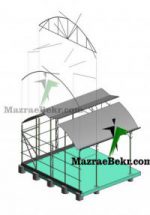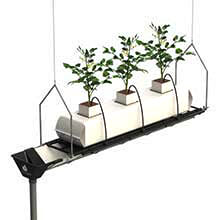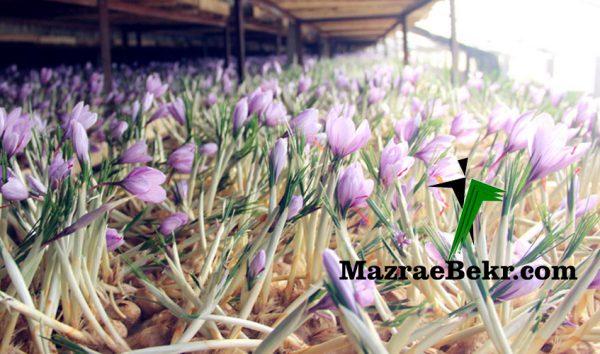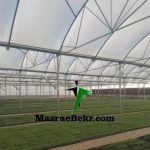Cultivation of saffron
Greenhouse cultivation of saffron (iroponic cultivation of saffron and hydroponic cultivation of saffron) has been thriving in the world for several years and is implemented in differentcountries. However, the question always arises, which is better between greenhouse cultivation of saffron and soil cultivation of saffron? In this article, we have reviewed the advantages and disadvantages of greenhouse cultivation of saffron so that we can be effective in your decision making process regarding the selection of cultivationmethods. then you can for get more information about salary of this greenhouse click here.
What kind of plant is saffron?
Saffron is one of the most expensive medicinal plants in the world with a flower cup consisting of three petals and three petals, and three yellow flags and a trident stigma in red garlic, a perennial plant belonging to the Iridacee family. The scientific name of this plant is Kirkus Sativus.
History of Saffron Cultivation
Saffron is a plant that is tied to the name of Iran and is essentially growing in arid and semi-arid regions of the country. Some researchers also consider the origin of saffron in a wider region of the planet, including Greece, Turkey, Asia Minor and Iran.
In ancient Persia, saffron was cultivated in Hamadan, Kermanshah, Ebershtjan and Qom, and some parts of Mazandaran. Iranians used saffron as an offering to God while worshipping. According to historical documents, Alexander al-Maqduni used saffron for bathing after dominating Iran, personally, following Cyrus. And like Cyrus, he believed in the health benefits of saffron. Arabs in the Sassanid era became familiar with saffron after Islam saffron was known as Borujerd, Nahavand, Rudavar, Ray Vasfahan.
Unfortunately, after the Mongol invasion of Iran, saffron cultivation became extinct in most parts of Iran. In conjunction with these days, saffron began working in Rajand Waqin (Quhistan, Qaynat) and its products have gained popularity and citizenship that has continued to this day. In the old medical and literary texts of the world, Iranian saffron is mentioned.
Saffron is not merely edible application.Yes there are many benefits and applications that are now oftenforgotten.
Saffron is currently cultivated in Iran, Egypt, Spain, China, Italy, Turkey, Switzerland andPakistan.
The benefits of saffron cultivation and the causes of farmers’ tendency to cultivate this crop
According to agricultural scientific research centers, evaluation of changes in saffron cultivation during the last 30 years shows that the cultivation of this crop has increased significantly in Iran, so that saffron is now cultivated in 21 provinces of the country at a level of 88,000 hectares. 95% of Iranian saffron is cultivated in Khorasan region. Torbat Heydariyeh, Gonabad, Birjand, Cain and Ferdows river are the main cultivated areas of Iranian saffron.
Now the question is, why do farmers tend to grow saffron?
1-Saffron, water requirement is low and the number of irrigation times is very suitable for cultivation in low water areas.This plant does not need water when it falls asleep.Note that although saffron is a water resistant plant but should not be placed in drought stress conditions because lack of soil moisture reduces saffron yield.
2-Saffron has high economic value and is highly regarded by global markets so that it is the most expensive agricultural product in the world and the most important agricultural export product in Iran.
Note: Due to recent droughts and lack of water resources and on the other hand, high economic value of saffron, farmers have been encouraged to cultivate this crop.
3-Easy cultivation of saffron and the need for low force for cultivation management
4-Low cost cultivation and no need to cultivate several times: saffron does not need to be stored, so you do not need to pay for storage.On the other hand, saffron onion remains in the ground for 7 4 and in some areas for up to 10 years and crops and in this regard does not need to replant saffron in the following years. After a few years, in addition to the annual saffron harvest profit, you can remove the onions from the soil and make a good profit by selling the onions.
5- Saffron cultivation plays an effective role in creating sustainable employment
Saffron has not only provided a suitable livelihood for households in terms of income creation, but it has also been able to provide suitable employment for people.
Economic planners of the country can promote the development of saffron cultivation to reduce unemployment and reduce the migration of villagers
6-Saffron plays an effective role in protecting water and soil resources
7- All parts of saffron can be used so that small onions and leaves, petals and petals as well as its flags are used in livestock, dyeing and beekeeping industries, respectively.
Iran’s global saffron market problems
Iran with more than 90% of the world’s saffron production is the largest producer of saffron among countries. However, we should not neglect the competitors in themarket.
Saffron cultivation has attracted much attention from different countries due to its added value and high profitableness. Afghanistan, uae, Spain and China are among the countries that have entered the saffron market in the past few years and have endangered Iran’s status
Currently, Spain is iran’s largest competitor in the global market and in recent years, with its extensive activities, it has been able to take part of Iran’s share in the global saffron market and reduce Iran’s share in this market
China has also harmed Iran’s saffron market by increasing the cultivation of saffron in greenhouse form and also through the sale of “fake and poor quality saffron” with the name of Iranian saffron, although these countries in terms of production cannot compete with Iran in the current conditions, but can hit the Iranian saffron market by exporting cheap or counterfeit saffron.
In recent years, in the shadow of unsupervised and smuggled saffron onions from Iran, the market of Saffron Afghanistan has gained a lot of profits and now the highest sales of saffron in China and even in Europe and the United States are dedicated to Afghanistan.

Benefits of greenhouse cultivation of saffron
1- Reducing water loss and increasing water use productivity, especially in countries like Iran that are facing a water shortage crisis
2-Increasing yield efficiency and harvesting compared to soil cultivation
3-Ability to perform in low area and maximum use of space and cultivation in class so that 10,000 square meters can be implemented in a 1000-meter environment.
4-Ability to do this type of cultivation everywhere
5- Increasing thequality of saffron stigmas and increasing saffron titration due to staying safe from direct sunlight and thus producing a more quality product
6-Facilitating the process of saffron harvesting
7-Better and easier control of fungal pests and diseases as well as increased control over environmental conditions so that spraying, weeding and weed fighting and controlled harvesting operations are easily performed.
8- In greenhouse cultivation of saffron, there are very suitable and hygienic environmental conditions and away from any kind of contamination compared to traditional cultivation
9-Greenhouses from the first year can be high profitability if the conditions are met, but in the soil cultivation in the fifth and sixth years of cultivation, it achieves excellent profitability.
10-Greenhouse cultivation of saffron causes more labor and job creation in the country
11- In the traditional method of saffron onion for a very long time and several years away from view and access buried under the soil which increases the disease in onion and soil is available in modern onion cultivation and necessary care is done easily and easily.
12- Humidity and light requirements are adjustable
Disadvantages of greenhouse cultivation of saffron (hydroponic cultivation and aeroponic cultivation)
1-Unaffiliation of saffron greenhouse patrol to soil cultivation and consequently cost of this type of cultivation for farmers
2-The initial cost of establishing these systems is high, although some experts in this field believe that in greenhouse cultivation of saffron due to the elimination of some costly agricultural operations such as land preparation, irrigation, etc. This initial cost is returned and makes a multiplier profit for producers.
3-For greenhouse cultivation of saffron, larger onions should be used than cultivation in soil, which also includes more cost.
4- Spending more time and employing more labor
History of greenhouse cultivation of saffron
The greenhouse cultivation of saffron was first implemented in China in 2006 by a young Chinese student named Mr. (Bonn), inthe world, and in2012, at the behest of the then-President of China, so that this type of cultivation is currently the main type of saffron cultivation in China.
Leading countries in greenhouse cultivation of saffron
Along with China as the largest producer of greenhouse saffron, countries such as Spain, UAE, Turkey, northern Afghanistan and India have also welcomed this type of cultivation.
Greenhouse Saffron Production in Iran
The greenhouse cultivation of saffron has recently been carried out in different countries and apparently has been very successful, so in our country, like other countries, people have been encouraged to build saffron greenhouses so that in addition to increasing production, they are spared from the possible damages of the beginning of the freezing season and rainfall. However, modern and greenhouse cultivation of saffron has not yet been able to reconstruct the special climate of areas such as Khorasan, Iran, and therefore the quality of greenhouse saffron cannot be compared with traditional saffron.
0 to 100 greenhouse saffron plantings
The first step in training 0 to 100 saffron plantingin the greenhouse is to provide thebasics of greenhouse cultivation of saffron, paying attention tothe type and structure of the greenhouse at this stage isnecessary.
In the second step, it is time to prepare the bed for the cultivation and cultivation ofsaffron.You can use wooden, metal and even plastic accordings.Our advice is to use wooden accordings because they are more durable.
Saffron Greenhouse Equipment
- Closed environment such as storage
- Agricultural land to transport onions to soil after flowering
- Cooling system (fan and pad, cooler) and heating system (heater and heater) and moisture supplier (fogger) heater
- Shelf and onion holders
Different stages of greenhouse saffron cultivation
1- Preparation of high quality and coarse saffron onions
Saffron onion is the main pillar of saffron greenhouse planting. In July, do not do this at all because it shocks the onions and this causes the onions to flower or produce flowers. and humidity is 40_55%
2- Transferring saffron onions to the cultivation hall
Before transferring the scallions into the hall, you must first disinfect the saffron salon and onion and then arrange them on the prepared floors in advance. This phase takes place in lateSeptember.
After placing the onions in the lead, the temperature should be 23 to 25 °C and humidity between 75 and 85% and prevent sunlight from entering the saffron greenhouse (the environment should be completely dark). Make sure the onion has no contact with water because it produces roots in the onion and can be removed from the onion power of saffron. At this point, the scallions begin to wakeup.
In October, along with the main onion buds, the minor sprouts begin to grow, which you should be sure to remove. After growing all scallions, bring the ambient temperature to 17 °C. This temperature is the best temperature for flowering saffron.
Onions begin flowering in late November or early December. Saffron onion flowering will take between 15 and 20 days. It is necessary to pick and clean the flowers everyday.
After harvesting the flowers, red stigmas should be separated from the saffron flower and cleared in different ways, and then sold to the market. In drying saffron, it should be careful to preserve its aroma andcolor.
Each scallion (15 to 20 grams) in greenhouse conditions produces an average of 12 to 14 flowers, the main benefit of a saffron greenhouse is that you can manage your onions to more than 30 grams by properly managing fertilizer and this leads to an increase in the number of flowers and ultimately the efficiency of your cultivation.
3- Transferring saffron scallions to the ground
After harvesting the flowers, scallions should be transferred to the pre-prepared ground as soon as possible, and at the time of transfer, it should be careful not to harm the scallion leaves. The composition of the soil to return saffron onion to the soil should be clay sandy and the desired area for each onion should be considered 10 square meters after planting saffron onion in the ground, the time of fertilization and irrigation of saffron is come. It should be noted that after transferring scallions to soil, the required elements of the plant should be provided by irrigation and folioping. The last fertilization and irrigation of saffron takes place in May at exactly the stage when saffron leaves begin to turn yellow. When fertilizing saffron, there should be no weed on theground.
Saffron planting steps in greenhouse
1: Separating the onion from the soil in June and keeping it in a ventilated environment
2: Transferring onions weighing more than 10 g to the greenhouse in September
3: In October, onions begin to germinate, it should be noted that saffron sub-buds should be removed because they reduce the possibility of flowering onions.
Note: The water needed for the onion is only through environmental spray and the use of ambient moisture, avoid direct contact of the onion with water.
4: From late November to early December, onions reach flowering and harvest time.
5: After harvesting saffron flowers, the onion is disinfected and by removing additional buds, it will be able to replant and crop for the next year.
Saffron Pests
Saffron pests are diverse and include species of plant ticks, insects and rodents such as hedgehogs, real mice and mole mice.
Greenhouse Saffron Cultivation
Greenhouse cultivation of saffron (saffron planting by iroponic and hydroponic method) has recently been carried out in different countries and apparently has been very successful. The biggest advantage of this type of cultivation is the maximum use of space and cultivation due to class and high cultivation density, which greatly reduces the cost of field preparation and operations related to land preparation, and on the other hand, increases crop production, in addition to this type of crop cultivation is produced in a healthier and healthier environment. There are disadvantages that we mention below.
Hydroponic cultivation of saffron
Hydroponics is one of the greenhouse cultivation methods of saffron, also called water cultivation. In this method, saffron plant has a short growth period and high growth rate. Soil is not needed in saffron cultivation by hydroponic method
Advantages of hydroponic cultivation of saffron
Using maximum greenhouse space and cultivation in class and consequently very high cultivation density
No need to prepare land and reduce costs
Reduce water consumption
Reduce the costs of fighting pests and diseases that threaten the plant
Easier control of light, humidity, temperature
Disadvantages of hydroponic cultivation of saffron
- High cost of investment. Because it requires experts and full automaticsystems.
- The quality of saffron obtained from this method is low compared to saffron cultivated in the traditionalway.
Aeropolionic cultivation of saffron or aeroponics
In this method, the roots of saffron are suspended in the soil and food and minerals are sprayed to the saffron plant.
In this method, the plant should not have any direct contact with water otherwise, it will be possible to rot the onion and transmit the disease
Advantages of Saffron Iroponic Cultivation
- Controlling pests, diseases and environmental conditions and keeping saffron onions safe from contamination and rodent attack
- Avoiding direct sunlight that reduces the risk of loss of taste, color and aroma of saffron
- Easy, manageable and risk-free spraying
- Reducing the losses of saffron bulbs failure
- Reduce water consumption
- Increasing production efficiency
- Easy and fast harvesting plants compared to saffron soil planting method
Disadvantages of Saffron Iroponic Cultivation
- High cost of these types of cultivation systems
- Low quality of saffron compared to traditional planting
Saffron planting in a home greenhouse
If you want to plant saffron in a small greenhouse, you can turn the roof of your house or one of the rooms into a greenhouse while observing threepoints.
1- Use the metal frame for the greenhouse structure.
2- Prepare a drip water supply system
3- Prepare 3 saffron cultivation molds and shelves.The distance between the onions on the shelf should be between 3-5 cm per row and the distance of 10-15 cm between both rows.
Saffron greenhouse income
Considering that in the first year of onions used in greenhouse is not of high quality and high quality, we should not expect a highproduct.
But in the second years onwards, due to the proper and timely feeding of the plant (irrigation and foliar application) and the weight gain of onions, this figure will reach over one kilogram of onions per tonne, the amount of your income from the saffron greenhouse is directly related to the amount of saffron harvested in the greenhouse, you can get acquainted with the details of this type of cultivation and how to obtain it.
Conclusion: All the above mentioned materials are not for confirmation or denial of greenhouse cultivation of saffron, but the purpose of expressing the necessary information about greenhouse planting of this crop, so that those who intend to do this type of cultivation should decide with knowledge. However, considering the advantages and disadvantages of greenhouse cultivation of saffron, we can say that doing or not doing greenhouse cultivation depends on the area of cultivation, facilities and conditions of each individual and cannot be easily recommended for all people.











